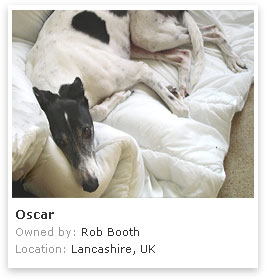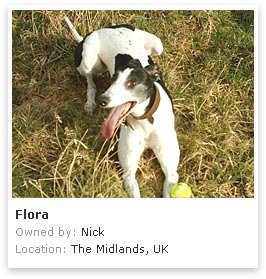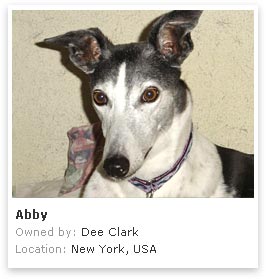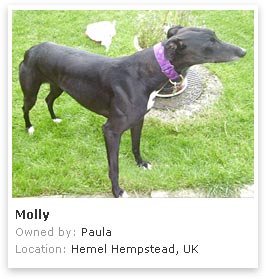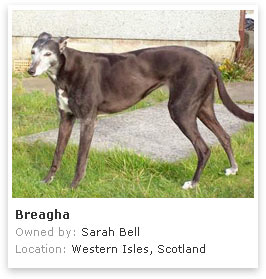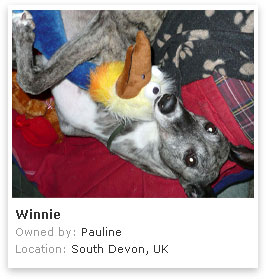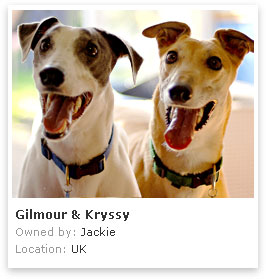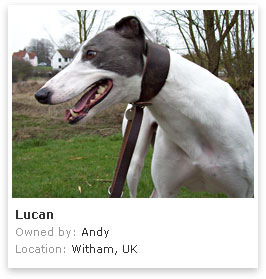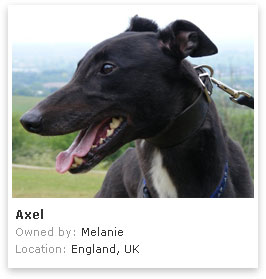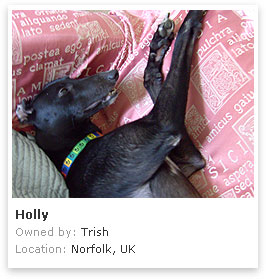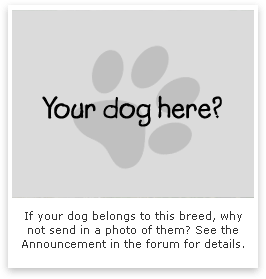OriginThere is no definitive answer as to the origin of the Greyhound, which is regarded as the prototype of all sight-hounds, but it is probable that it evolved in the North African and Middle Eastern deserts. It is certainly an ancient breed as proven by depictions of Greyhound type dogs in drawings and on artefacts dating back to 6,000 BC. and has changed little in either form or function over the millennia. The origin of the name itself is even more open to speculation: Latin, Saxon, or Old English, but most are in agreement that the name is nothing to do with colour. The principle role of the Greyhound was as a hunting dog capable of running down swift and nimble prey such as antelope and hare. In the 1800s hare coursing became a popular sport with the well-to-do in England and it is from this sport that Greyhound racing developed. Lean, lithe, with great lung and heart capacity and a ground-devouring stride of 5 metres (16.4 feet) the Greyhound is the perfect running machine capable of astonishing acceleration (70 km/h in 30 metres), and able to maintain high speed over distance. For many hundreds of years the ownership of these beautiful dogs was restricted to the nobility - in 1016 King Canute decreed that “no meane [ordinary] person may keep any greihounds”, and in some societies the penalty for killing a Greyhound was death. Now tens of thousands are bred each year for the track and thousands that fail to come up to expectations or are surplus to requirements are killed each year. For those that know this hound as a pet or show dog no other can surpass it for grace, beauty, unassuming refinement and loving loyalty.
Character:The Greyhound is renowned for his gentle, affectionate nature and his stable temperament. He is a pet and companion par excellence. He thrives on human company and will repay the love and attention he receives a hundredfold with his own unstinting love and unswerving devotion. His need for, and enjoyment of, human companionship means that he is not a dog to be relegated to a lonely existence in a backyard kennel run. Nor is he physically able to cope with extremes of heat and cold. His thin skin and lack of body fat means that he is best suited to an indoor life where he can doze in front of a fire or on a cosy bed in winter and can find relief from the heat of the sun in summer. For all his size he will curl up like a cat and occupy very little space inside. Although aggression is foreign to his nature the Greyhound can be reserved with strangers and will not fawn or make friends indiscriminately. He is not a traditional watchdog but he will alert to strangers on ‘his’ territory and, as he is not a noisy dog and does not bark unnecessarily it is always worthwhile to investigate when he does give voice. He is generally good with children but is not the dog for rough-housing, and teasing should never be permitted. Contrary to popular belief he can live in harmony with cats if trained to do so, but it must not be forgotten that he is basically a hunter born to chase running small game. He is also a very sensitive dog who will empathize with his owner’s joys and sorrows. This proud, elegant, fleet-footed aristocrat of the canine world is a wonderful companion for old and young, families and individuals. If you think that a Greyhound may be the dog for you please consider an ex-racer. Hundreds are always available from the specialist Greyhound adoption societies. Such dogs will have been temperament tested, tested for their reliability with cats and other small pets, health checked and neutered. If you choose a rescue Greyhound you will not only be giving a low-maintenance, good natured, tractable, incredibly beautiful animal the chance of a normal life but your own life will also be immeasurably enriched.
Exercise:Too often Greyhounds are dismissed as suitable companions through the misplaced belief that they need a vast amount of exercise when in fact their requirements are very modest. They are sprinters, not marathon runners and, while they will be happy to keep you company on hikes, two brisk 20 minute walks a day will be sufficient to keep them trim and mentally stimulated. As a bonus Greyhounds walk very well on the lead. Care should be taken to exercise off-lead only in secure areas as anything that runs will trigger the chase instinct. If such an area can be found your dog will appreciate the opportunity to run, but he is quite content to laze around at home and enjoy his leisure in your company. The canine sport of lure-coursing is an excellent way to provide sprinting exercise.
Training:The Greyhound is a very intelligent, trainable dog and, in the case of puppies, basic obedience should be started as early as possible. The older dog may take a little longer to learn but his innate desire to please and his willingness to work for a loved and respected owner make training a pleasure. Rough handling and angry reprimands should never be used as he is not physically or emotionally equipped to deal with such methods and his confidence and trust will be severely undermined if he is subjected to harsh discipline. The object of training is willing compliance and this is best achieved through positive, motivational methods using treats and praise. Socialization to introduce him to as many various people and novel sights, sounds and situations should be an on-going process. The well-trained, well socialized Greyhound will meet life with confidence and will be a great ambassador for his breed.
|
KC Group:
Hound
KC, AKC, FCI recognized?
Yes
Size:
Large
Height:
Dogs: 71 - 76 cm (28 - 30 ins)
Bitches: 69 - 71 cm (27 - 28 ins)
Weight:
Dogs: 29 - 32 kg (65 - 70 lbs)>br />Bitches 27 - 29 kg (60 - 65 lbs)
Colour:
Black, white, red, fallow, blue, brindle or any of these with white
Lifespan:
10 - 12 years/p>
Coat:
Fine, short, close
Grooming:
Easy
Health issues:
Familial vasculopathy, cutaneous asthenia, deafness, haemophilia A (factor VIII deficiency), megaesophagus, pannus, pattern baldness, progressive retinal atrophy (PRA), susceptible to gastic dilitation volvulus (GDV), bloat, sensitive to some drugs and anaesthetic agents

|



